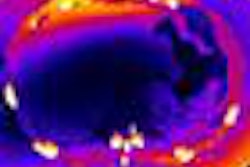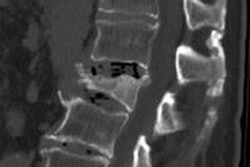WASHINGTON, DC - The use of low-dose CT protocols could produce disturbing discrepancies in measurements of lung nodule and lymph node volumes compared with high-dose scans, according to according a study presented Wednesday at the American Roentgen Ray Society (ARRS) meeting.
Researchers from Massachusetts General Hospital revealed that the size and volume of lymph nodes were approximately 30% lower in five cases and 10% greater in 15 subjects when low-dose CT was used, compared with higher-dose results. Size and volume of lung nodules were as much as 46% lower in nine cases and 34% greater in 10 cases with low-dose exposure.
The fluctuations can be a problem, because establishing the characteristics of lymph nodes and lung nodules is critical to determining appropriate patient treatment and assessing the success of that therapy. The discrepancy is especially problematic given the recent interest in low-dose CT protocols.
Higher image noise?
Lead study author Dr. Beth Vettiyil and colleagues speculated that increased image noise on the lower-dose scans may have caused the results to vary so significantly, adding that the use of software to perform the measurements without a radiologist's clinical correlation might not be advisable right now.
In this study, the researchers used postmortem chest CT scans acquired within six hours of death on either a dual-source 128-detector-row CT scanner (Somatom Definition Flash, Siemens Healthcare) on 13 men and four women with a mean age of 64.1 years, or a 64-detector-row CT scanner (Discovery CT750 HD, GE Healthcare) on two men and one woman with a mean age of 58 years.
"We try to do the postmortem scan as close to death as possible, so we still have inflated lungs and can delineate the pathology very well," explained study co-author Dr. Sarabjeet Singh during his ARRS presentation.
The high-dose protocol ranged from 200 to 300 mAs, while the low-dose technique ranged from 40 to 60 mAs. All other scan parameters stayed the same.
Researchers also utilized 3D image processing tools designed to better delineate lesions at low radiation doses. Image processing software (MIM, MIM Software) measured 20 lung nodules and 20 mediastinal lymph nodes on coregistered CT images.
Software calculations
The researchers found significant variations in nodule volume for the low-dose scans, based on calculations made by the 3D image processing software. In nine cases, volume was calculated as being an average of 46% lower, with average volume measured at 0.5 (± 0.5) mL for low-dose scans, compared with 1.3 (± 1.1) mL for the high-dose scans.
For another 10 cases, volume was actually calculated an average of 34% higher, with an average volume of 1.7 (± 1.8) mL for the low-dose studies, compared with an average volume of 1.0 (± 1.0) mL for the high-dose images.
In addition, mediastinal lymph node volumes were estimated as 30% lower in five low-dose scans, with an average volume of 0.026 (± 0.008) mL, compared with an average volume of 0.036 (± 0.008) mL for high-dose cases. In 15 cases, low-dose measurements were calculated to be 10% greater, with average volumes of 0.027 (± 0.013) mL compared with average volumes of 0.023 (± 0.01 mL) in high-dose cases.
Average attenuation values showed no significant difference between high- and low-dose images. Noise was 14% higher at 83.4 (± 89.5) Hounsfield units (HU) for low-dose scans, compared with 79.2 (± 92.4) HU for high-dose studies of lung nodules. Noise for lymph nodes was 43% greater at 43.0 (± 15.7) HU at low doses, compared with 31.9 (± 10.7) HU at high doses.
Based on the results and the variations with the lung nodules and lymph nodes based on radiation dose, Vettiyil and colleagues concluded that while there are different types of quantitative tools to measure lesion size and volume, the use of such software should be done with a radiologist's clinical oversight.



















